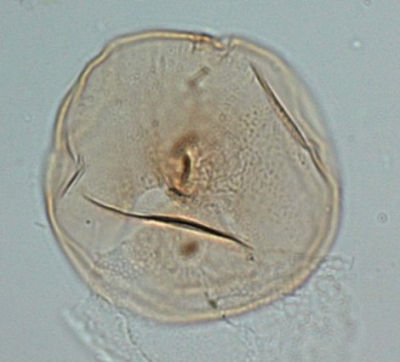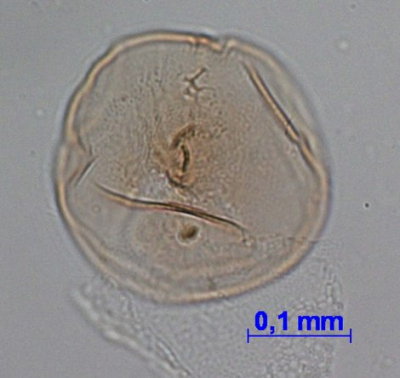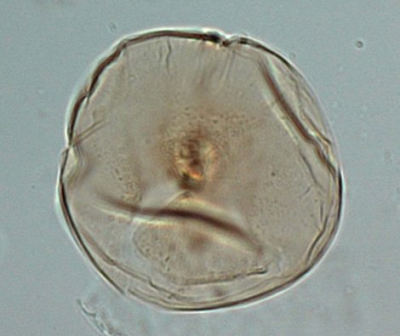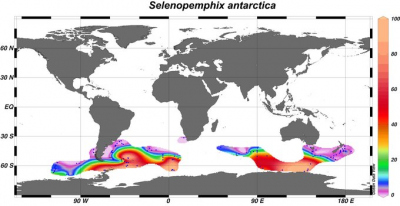Page path:
- Modern Dinocyst Key
- brown cysts
- cysts with peridinioid form
- Cysts without spines/processes
- Selenopemphix antarctica
Selenopemphix antarctica
Zonneveld, K.A.F. and Pospelova V. (2015). A determination key for modern dinoflagellate cysts. Palynology 39 (3), 387- 409.



apical view
Sample PS2366-2, EFC: J37-1/2
Southern Ocean, Atlantic Sector
photographs: Karin Zonneveld
Sample PS2366-2, EFC: J37-1/2
Southern Ocean, Atlantic Sector
photographs: Karin Zonneveld
cross section
apical view 2
Field characteristics
Selenopemphix antarctica Marret et de Vernal 1997
Field haracteristics:
Peridinoid cyst with an almost circular outline in polar view, extremely compressed apically-antapically, has one short apical and two short antapical horns. Wall is faintly ornamented, with granulation concentrated around and on the top of both apical and antapical horns. Cyst wall has a pale brown colour to semi-transparent. Archeopyle is intercalary, and a laterally offset to the left of the longitudinal axis.
Dimensions: Cyst body diameter: 40 to 102 µm (polar view).
Comparison with other species:
The most characteristic feature of this species is the granulation around the apical and antapical horns. This species can be easily missed since it is often very thin. It is as far as we have observed only present in apical/antapical position in a microscopic slide
Field haracteristics:
Peridinoid cyst with an almost circular outline in polar view, extremely compressed apically-antapically, has one short apical and two short antapical horns. Wall is faintly ornamented, with granulation concentrated around and on the top of both apical and antapical horns. Cyst wall has a pale brown colour to semi-transparent. Archeopyle is intercalary, and a laterally offset to the left of the longitudinal axis.
Dimensions: Cyst body diameter: 40 to 102 µm (polar view).
Comparison with other species:
The most characteristic feature of this species is the granulation around the apical and antapical horns. This species can be easily missed since it is often very thin. It is as far as we have observed only present in apical/antapical position in a microscopic slide
Geographic distribution
Geographic distribution based on :
Zonneveld et al., 2013. Atlas of modern dinoflagellate cyst distribution based on 2405 datapoints. Review of Palaeobotany and Palynology, v. 191, 1-197
Zonneveld et al., 2013. Atlas of modern dinoflagellate cyst distribution based on 2405 datapoints. Review of Palaeobotany and Palynology, v. 191, 1-197
Selenopemphix antarctica is a temperate to polar species endemic to the southern oceans. Its northernmost distribution is marked by the southern Hemisphere subtropical front. Highest relative abundances occur south of the polar front. It is restricted to full-marine environments with well ventilated bottom waters. These areas are characterized by high nitrate and phosphate concentrations in surface waters but low productivity.

Distribution:
Selenopemphix antarctica has a temperate to polar distribution and is observed on the Southern Hemisphere only. Its northern distribution limit is the southern Hemisphere subtropical front. Abundances > 20% occur south of the polar front. In Antarctic waters it can form up to 100% of the association. S. antactica occurs in coastal and open ocean areas of the southern oceans.
Environmental parameters:
SST: -2.0 - 23.5°C (winter - summer), SSS: 33.2 - 36.3 (summer - autumn), [P]: 0.19 - 2.10 μmol/l) and nitrate, [N]: 0.71 - 30.62 μmol/l, chlorophyll-a: 0.12 - 1.11 ml/l, bottom water [O2]: 3.9 - 6.0 ml/l.
Selenopemphix antarctica can be abundant in regions where SST: remains < 0°C throughout the year. Abundances > 20% occur where SST: are< 0°C in winter and spring and up to 10°C in summer. S. antactica is not recorded from sites that are characterised by seasonal melting of ice. It is typical present in so called „high nutrient/low chlorophyll“ environments. in this dataset its distribution is restricted to sites where well-ventilated bottom waters are present although it has been observed in anoxic basins around Antarctica as well (Sangiorgi pers. comm. 2012).
Comparison with other records:
Selenopemphix antarctica has not been recorded from regions not covered by this Atlas.
Selenopemphix antarctica has a temperate to polar distribution and is observed on the Southern Hemisphere only. Its northern distribution limit is the southern Hemisphere subtropical front. Abundances > 20% occur south of the polar front. In Antarctic waters it can form up to 100% of the association. S. antactica occurs in coastal and open ocean areas of the southern oceans.
Environmental parameters:
SST: -2.0 - 23.5°C (winter - summer), SSS: 33.2 - 36.3 (summer - autumn), [P]: 0.19 - 2.10 μmol/l) and nitrate, [N]: 0.71 - 30.62 μmol/l, chlorophyll-a: 0.12 - 1.11 ml/l, bottom water [O2]: 3.9 - 6.0 ml/l.
Selenopemphix antarctica can be abundant in regions where SST: remains < 0°C throughout the year. Abundances > 20% occur where SST: are< 0°C in winter and spring and up to 10°C in summer. S. antactica is not recorded from sites that are characterised by seasonal melting of ice. It is typical present in so called „high nutrient/low chlorophyll“ environments. in this dataset its distribution is restricted to sites where well-ventilated bottom waters are present although it has been observed in anoxic basins around Antarctica as well (Sangiorgi pers. comm. 2012).
Comparison with other records:
Selenopemphix antarctica has not been recorded from regions not covered by this Atlas.


